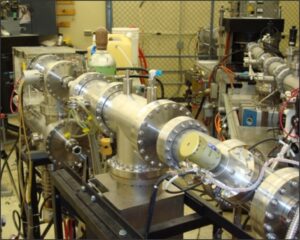Voltage |
Ion source |
Ions and beam energies |
| 10 kV | Gas ion source | H, He, C, O, N, Ar, etc.., 5 keV to 20 keV |
| 140 kV | Gas ion source | H, He, C, O, N, Ar, etc.., 50 keV to 280 keV, depending on ion charges |
| 400 kV Van de Graaff | Gas ion source | H, He, N, Ar, Xe, Kr, 200 keV to 1.2 MeV, depending on ion charges |
| 1.7 MV General Ionex | Sputtering + plasma dual ion source | Almost all ions from the elemental table, 800 keV to 3.5 MeV |
| 3 MV NEC tandem | Sputtering + plasma dual ion source | Almost all ions from the elemental table, 800 keV to 8 MeV |
10 kV Accelerator
The 10 kV accelerator is custom-built and has a maximum terminal voltage of 10 kV. Depending on the voltage configuration and ion charges, it iscapable of generating ion beams ranging from 5 keV to 20 keV. The current ion source exclusively produces gas atoms, enabling the creation of H, He, O, and Ar beams. Despite its compact size, this mini accelerator is equipped with all the essential components found in modern accelerators, including beam deflection, rastering, and bending magnet. As a result, the emitted beam boasts both energy and mass precision. Presently, the 10 kV accelerator is set up as a side beam within a triple-beam configuration. The beam lines of the 10 kV, 400 kV, and 1.7 MV accelerators share a common target chamber, facilitating the simultaneous bombardment of three beams.
Application: The 10 kV accelerator is unique in low-energy ion bombardment experiments and the simulation of the first-wall irradiation environment of a fusion device.
140 kV Accelerator
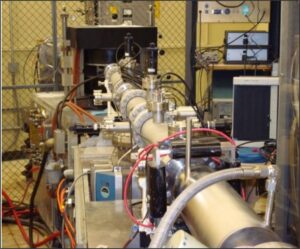
The 140 kV accelerator is custom-build with a gas ion source. Its terminal voltage is adjustable within the range of 50 kV to 140 kV, facilitating beam energies from 50 keV to 280 keV for ions such as H, He, C, O, Ar, and more. The beam line incorporates a deflection mechanism following a mass magnet, which effectively filters out neutral beams (ions that lose charge due to interaction with residual gas). This enhances the precision of dose control. The beam also has the capability to be rastered over an area exceeding 1 cm x 1 cm. Furthermore, the beam chamber is designed to support irradiation at temperatures ranging from liquid nitrogen levels up to 700°C.
Application: The primary applications of this accelerator encompass high-fluence ion implantation of gas atoms and the simulation of radiation damage within fusion devices.
400 kV Accelerator
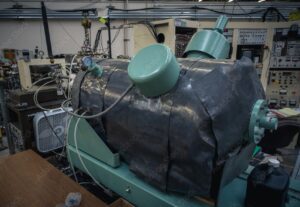
The 400 kV Van de Graaff accelerator features an adjustable terminal voltage ranging from 100 kV to 400 kV. This range allows for the production of gas ions with energies spanning 100 keV to 1.2 MeV, depending on ion charge. The ion source is limited to gas ions like H, D, He, N, O, Ar, and Xe. The accelerator is equipped with a mass magnet. Its beam line is integrated with a versatile target chamber, allowing simultaneous ion bombardment from the 10 kV, 400 kV, and 1.7 MV accelerators. Unlike tandem designs that necessitate a change in ion charge in the middle of the accelerator tank, this Van de Graaff accelerator does not alter ion charge. This characteristic enables it to generate noble gas ions with substantial currents.
Applications: This accelerator generates strong noble gas ion beams, making it suitable for concurrent ion irradiation using double or triple ion beams to emulate fusion first-wall testing.
1.7 MV General Ionex Accelerator
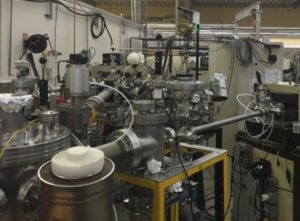
The 1.7 MV General Ionex Accelerator is a commercial accelerator with the capability to produce beams within the energy range of 700 keV to 3.5 MeV, contingent upon ion charges. This accelerator features dual ion sources, including a Duoplasmatron ion source for generating helium ions and a SNICS (Source of Negative Ions by Cesium Sputtering) source. The SNICS ion source can create ions from solid-state cathode materials like Ni, Fe, Zr, Au, etc. This accelerator operates as a tandem accelerator, changing the charge of ions from negative to positive after undergoing stripping by a nitrogen gun within the accelerator tank. It is equipped with multiple beam lines for ion irradiation and ion beam analysis. For ion irradiation, the temperature can reach up to 1200°C using a custom-built hot stage. The accelerator also enables double or triple beam irradiations through the 10 kV, 400 kV, and 1.7 MV accelerators.
Applications: This accelerator is unique for its ability to provide high beam current proton irradiation and high displacement per atom (dpa) heavy ion irradiation, both of which are valuable for emulating conditions within a fission reactor environment. The triple beam irradiation can simulate damage caused by H + He + neutron irradiation, which is typical of a fusion device.
3 MV General Ionex Accelerator
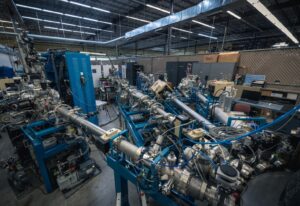
The 3 MV NEC tandem accelerator is a commercial device designed to create ions within an energy range of 800 keV to 8 MeV. It can even generate higher-energy beams for heavy ions. Commonly, it accelerates proton ions and heavy ions like Fe, Ni, and Au within the 800 keV to 5 MeV range. The accelerator follows a tandem design and features a dual ion source: a helium plasma source and an SNICS (Source of Negative Ions by Cesium Sputtering) ion source. It changes the charge of ions from negative to positive midway through its tank. The accelerator has four beam lines after its high-energy mass magnet. One of these beam lines allows ion beam analysis within a temperature range from liquid nitrogen to 500°C. Another beam line is used for ion irradiation of nuclear and radioactive materials, with protective radiation shielding. The third beam line is dedicated to high-resolution Rutherford backscattering spectroscopy, with an energy resolution of about 1 keV. The fourth beam line is connected to a molten salt corrosion cell, enabling simultaneous ion irradiation and corrosion testing.
Applications: The accelerator excels in prolonged high beam current heavy ion irradiation, which is particularly valuable for introducing significant damage levels in nuclear materials.
* The hourly rate for both internal and external usage of accelerator beam time is $156 per hour, as approved by the College of Engineering.

